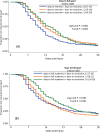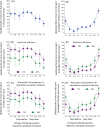Progression through return-to-sport and return-to-academics guidelines for concussion management and recovery in collegiate student athletes: findings from the Ivy League-Big Ten Epidemiology of Concussion Study
- PMID: 35444018
- PMCID: PMC9252856
- DOI: 10.1136/bjsports-2021-104451
Progression through return-to-sport and return-to-academics guidelines for concussion management and recovery in collegiate student athletes: findings from the Ivy League-Big Ten Epidemiology of Concussion Study
Abstract
Objective: To examine the progression of collegiate student athletes through five stages of a return-to-activity protocol following sport-related concussion (SRC).
Methods: In a multisite prospective cohort study, we identified the frequency of initial 24-48 hours physical and cognitive rest, and the sequence of (1) symptom resolution and return to (2) exertion activity, (3) limited sport, (4) full sport and (5) full academics. In resulting profiles we estimated the likelihood of return to full sport ≤14 days or prolonged >28 days and tested for variability based on timing of the stages.
Results: Among 1715 athletes with SRC (31.6% females), 67.9% had 24-48 hours initial physical and cognitive rest. The median was 6 days to return to full academics, 8 days to symptom resolution and 9 days to exertion. Three profiles emerged; all had the same sport-specific return progression, but varied in the relative timing of full academics. In unadjusted analyses, full academics as the first stage corresponded to the longest time to return to full sport, and initiating exertion the same day as symptom resolution resulted in the shortest time. In adjusted regression analyses, athletes initiating full academics while still symptomatic were 21.5% less likely (95% CI -27.4% to -15.5%) to return to full sport ≤14 days and, analogously, 19.1% more likely (95% CI 13.4% to 24.7%) to have prolonged return >28 days. While additionally controlling for initial rest, sex, symptom count and concussion history, the likelihood of prolonged return >28 days was 37.0% (95% CI 25.2% to 48.8%) in athletes initiating exertion considerably before symptoms resolved (ie, 7+ days), but only 3.6% (95% CI -1.4% to 8.6%) in athletes initiating exertion shortly before achieving symptom resolution (ie, 3-4 days).
Conclusion: We found evidence that sequential progressions were consistent with current recommendations including brief initial rest, and the initiation and relative timing of each stage impacted the final return-to-sport outcome.
Keywords: Cohort Studies; Sporting injuries; Sports.
© Author(s) (or their employer(s)) 2022. Re-use permitted under CC BY. Published by BMJ.
Conflict of interest statement
Competing interests: This research was conducted as an activity of the Ivy League–Big Ten Epidemiology of Concussion Study, which is an initiative of the Big Ten–Ivy League Traumatic Brain Injury Research Collaboration. DJW is Principal Investigator of the Concussion Study, BAD is a PhD student, and ACB is a postdoctoral fellow involved with study management and research. Ivy League and Big Ten University and Conference leadership played no role in approving, interpreting, or permitting the present analysis to be conducted or published. DJW has consulted for the National Collegiate Athletic Association (NCAA).
Figures





References
-
- American Academy of Pediatrics . Recommendations for participation in competitive sports. Pediatrics 1988;81:737. - PubMed
MeSH terms
Grants and funding
LinkOut - more resources
Full Text Sources
Medical
Miscellaneous
